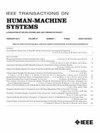Variable Handle-Resistance Based Joystick for Post-stroke Neurorehabilitation Training of Hand and Wrist in Upper Extremities
IF 4.4
3区 计算机科学
Q2 COMPUTER SCIENCE, ARTIFICIAL INTELLIGENCE
引用次数: 0
Abstract
The objective was to modulate the resistance of a hand-held device, e.g., joystick, for customizing a rehabilitative therapeutic patient-centric virtual environment protocol. Two similar sets of springs (each set having three springs with graded rigidness) were customized to increase the handle-resistance. The springs were experimentally calibrated to determine individual spring-constant value. The amount of exerted force values during joystick movements were standardized in a cohort of healthy subjects (基于可变手柄阻力的操纵杆在中风后上肢手腕神经康复训练中的应用
目标是调节手持设备的阻力,例如操纵杆,用于定制康复治疗以患者为中心的虚拟环境协议。定制了两组类似的弹簧(每组有三个具有分级刚度的弹簧)以增加手柄阻力。对弹簧进行了实验校准,以确定单个弹簧常数值。在一组健康受试者(n = 15)中,对操纵杆运动过程中施加的力值进行标准化。计算变异系数(CV)以确定健康受试者之间的变异性。此外,五名(n = 5)中风患者参加了这项初步研究,并使用不同的弹簧进行了三次独立的虚拟现实会话。任务性能指标,即完成时间,轨迹平滑度和相对误差,对每个级别进行评估。实验结果表明,增加刚度后弹簧的弹性常数分别为1.34 × 103±16.1、2.23 × 103±29.8和6.47 × 103±470.9 N/m。观察到不同操纵杆运动的平均力值随着弹簧刚度的增加而线性增加。计算的CV≤14%表明健康受试者记录的力值存在变异性。与会话1相比,会话2和会话3的任务表现指标和视觉模拟量表疲劳得分增加,表明会话2和会话3的任务难度增加。
本文章由计算机程序翻译,如有差异,请以英文原文为准。
求助全文
约1分钟内获得全文
求助全文
来源期刊

IEEE Transactions on Human-Machine Systems
COMPUTER SCIENCE, ARTIFICIAL INTELLIGENCE-COMPUTER SCIENCE, CYBERNETICS
CiteScore
7.10
自引率
11.10%
发文量
136
期刊介绍:
The scope of the IEEE Transactions on Human-Machine Systems includes the fields of human machine systems. It covers human systems and human organizational interactions including cognitive ergonomics, system test and evaluation, and human information processing concerns in systems and organizations.
 求助内容:
求助内容: 应助结果提醒方式:
应助结果提醒方式:


